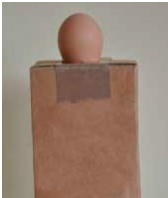Candling eggs
Candling gets its name from people who used candles as the light source to view the inside of an egg. Candling is done to monitor how the embryos are growing by examining the egg fertility, embryo viability, moisture level and other aspects. In short candling eggs allows you to keep track of the progress of your egg during incubation.
 You can use a candling torch or make your own candler using a light bulb as the light source. The light penetrates the egg and makes it possible to observe the inside of the egg. The easiest way to make a candler is to place a low energy light bulb inside a cardboard box. Cut on top of the box a big enough round hole to stand the large end of the egg. Place egg onto this hole and turn the light on. Do this in a dark room and limit the exposure of the egg to the hot light source and you will be able to observe the contents of the egg.
You can use a candling torch or make your own candler using a light bulb as the light source. The light penetrates the egg and makes it possible to observe the inside of the egg. The easiest way to make a candler is to place a low energy light bulb inside a cardboard box. Cut on top of the box a big enough round hole to stand the large end of the egg. Place egg onto this hole and turn the light on. Do this in a dark room and limit the exposure of the egg to the hot light source and you will be able to observe the contents of the egg.
 The content of white eggs with thin shells is easier to see than that of darker colored eggs and those with thicker shells. Eggs can be out of the incubator for 20 – 30 minutes without any impairment.
The content of white eggs with thin shells is easier to see than that of darker colored eggs and those with thicker shells. Eggs can be out of the incubator for 20 – 30 minutes without any impairment.
The presence of embryos can be confirmed easily after 8 to 12 days of incubation. With practice you can be able to identify the embryo located in the large end of the egg by the spider-like blood veins radiating under the surface of the shell. The embryo occupies most of the egg by the 18th day and chicken eggs should not be candled after that. The air sac size increases as moisture evaporates from the egg. If the humidity is too high, the air sac will be smaller and if too low the air sac will be larger than normal.
 If the embryo dies, the blood draws away from the embryo and forms what is called a blood ring. Such abnormalities as bloody whites, blood spots, meat spots, and cracked shells can be detected. By being able to identify and remove non-viable incubating eggs you avoid the risk of rotten eggs exploding and infecting your hatch with dangerous microbes. Healthy embryos will respond to the light by moving. Sometimes the movement is very sluggish and it can take 30 to 40 seconds for the embryo to move when held under the candling lamp. This indicates the embryo is not healthy and the egg should be discarded.
If the embryo dies, the blood draws away from the embryo and forms what is called a blood ring. Such abnormalities as bloody whites, blood spots, meat spots, and cracked shells can be detected. By being able to identify and remove non-viable incubating eggs you avoid the risk of rotten eggs exploding and infecting your hatch with dangerous microbes. Healthy embryos will respond to the light by moving. Sometimes the movement is very sluggish and it can take 30 to 40 seconds for the embryo to move when held under the candling lamp. This indicates the embryo is not healthy and the egg should be discarded.




Comments
RSS feed for comments to this post